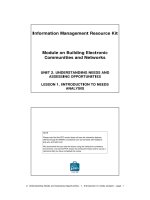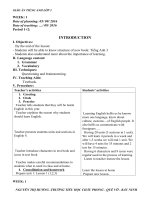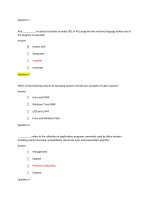Contrastive linguistics unit 1: introduction
Bạn đang xem bản rút gọn của tài liệu. Xem và tải ngay bản đầy đủ của tài liệu tại đây (134.03 KB, 39 trang )
Contrastive Linguistics
Unit 1: Introduction
Assoc. Prof. Dr. Hoang Tuyet Minh
Email:
Phone: 0915090670
Syllabus
- Number of credits: 3
- Class sessions: 9
Testing and assessment:
- Class attendance/ projection
10 %
- Mid-term test and 15-minute group presentation
20%
- Final test: a 15-page assignment
70%
Core books
Carl, J (1980). Contrastive Analysis . Harlow, Essex:
Longman.
Lado, R. (1957). Linguistics across Cultures. University of
Michigan Press, Ann Arbor.
Richard, J. (1984). Error Analysis. Longman: London and
New York.
Lê Quang Thiêm. (2004). Ngôn ngữ học đối chiếu. NXB
ĐHQG Hà Nội
Trần Hữu Mạnh. (2007). Ngôn ngữ học đối chiếu – Cú pháp
tiếng Anh – tiếng Việt. NXB Đại học Quốc qia Hà Nội.
Nguyễn Văn Chiến (1992). Ngôn ngữ học đối chiếu và đối
chiếu các ngôn ngữ Đông Nam Á. Nxb ĐH Sư phạm Ngoại
ngữ.
Contents
Unit 1: Introduction
Unit 2: Major issues of Contrastive
linguistics
Unit 3: Microlinguistics &
Macrolinguistics
Unit 4: Pedagogical Exploitation of
CAs
Contrastive linguistics (CL):
what is it?
Contrastive linguistics is the systematic
comparison of two or more languages,
with the aim of describing their similarities and
differences,
focusing, however, on differences,
it is predominantly practical.
The term “contrastive linguistics”
was used for the first time by Whorf in 1941.
CL and Linguistics
general linguistics
theory of linguistics
similarities in languages
what is common to all languages in the world
comparative linguistics
differences between languages
typology of languages
aiming at classification of all languages in the world
synchronic or
diachronic
CL and Comparative linguistics
comparative linguistics
contrastive linguistics
differences (and similarities) between two
(usually) languages
Contrastive linguistics
differences (usually) between two (usually)
languages
basis for typological description
mainly practical applications
translation
foreign language teaching and learning
bilingual lexicography (dictionaries)
why differences?
it is assumed that the two languages are similar except
for the points described as different
CL in linguistics
the languages being compared can be related
Polish and English
or can be unrelated
like Polish and Chinese
can be from the same historical period
Polish and English in the 20th c.
or can be from different historical periods
English and Polish from the 16th and the 20th c.
CL in linguistics
usually, however,
CL is synchronic comparative linguistics
without the historical dimension
CL can be
theoretical
applied
Theoretical CL
gives an exhaustive account of the differences
and similarities between two or more languages,
provides an adequate model for their
comparison.
Applied CL
on the basis of the theoretical framework
provided by theoretical CA/CS,
gives the researcher the information necessary
to conduct actual contrastive analyses.
The rationale for studying CL
who:
prospective teachers of a foreign language
CL and a FL teacher
why:
contrastive studies are (were) used as a means of
predicting and/or
explaining difficulties of second language learners
with a particular mother tongue (Vietnamese)
in learning a particular target language (English)
however, CL does not explain all problems of foreign
language students
CL and a FL teacher
other hypotheses to explain the problems in
learning/teaching a foreign language
error analysis
performance analysis
interlanguage studies
language awareness studies
these belong to applied linguistics
foreign language learnign/teaching methodology
What to compare
early contrastive studies focused on
microlinguistic analysis
phonology/phonetics
grammar (syntax, inflection)
lexis
today there are also
contrastive pragmatics
cross-cultural/intercultural pragmatics
contrastive rhetoric
What to compare
microlinguistic analysis: examples
What are the consonant phonemes in languages X and
Y?
How do they differ in inventory, realization, and
distribution?
What is the tense system of languages X and Y?
What are the verbs of saying in languages X and Y?
What to compare
pragmatic analysis: examples
How is cohesion expressed in languages X and Y?
How are the speech acts of apologizing and requesting
expressed in languages X and Y?
How are conversations opened and closed in
languages X and Y?
This course
mainly practical
basic theoretical notions
a review of microlinguistic contrasts
How to compare?
what is the basis for comparison?
comparison of seemingly related phenomena:
“to compare them would be tantamount to putting tenton lorries and banana skins in the same class on the
grounds that neither ought to be left on footpaths”.
(Carl James 1980,167)
How to compare?
object A
object B
either have something in common
and we can compare them
or do not have anything in common
and we cannot compare them
it is arguably difficult to find objects that do not
have anything in common
but:
God and ...
How to compare?
that something in common
is not A
is not B
is C
C is called Tertium Comparationis (TC)
Types of TC’s
formal correspondence, for CA of word order, function
words, inflections, affixation, suprasegmentals;
alliteration, rhymes
semantic equivalence, for CA of meaning of words,
phrases and sentences
pragmatic/functional equivalence, for CA of
meaning/function of texts, structure of discourse,
stylistic properties, quantitative aspects of text
Tertium Comparationis
what is common in comparison between
languages
is probably the meaning of a pair of sentences,
in other words,
their translation equivalence
Translation equivalence
there is one big problem
CL
studies the systems of two languages
translation is not about systems
it is about texts
this is a basic distinction in linguistics
system and text
langue and parole
competence and performance









